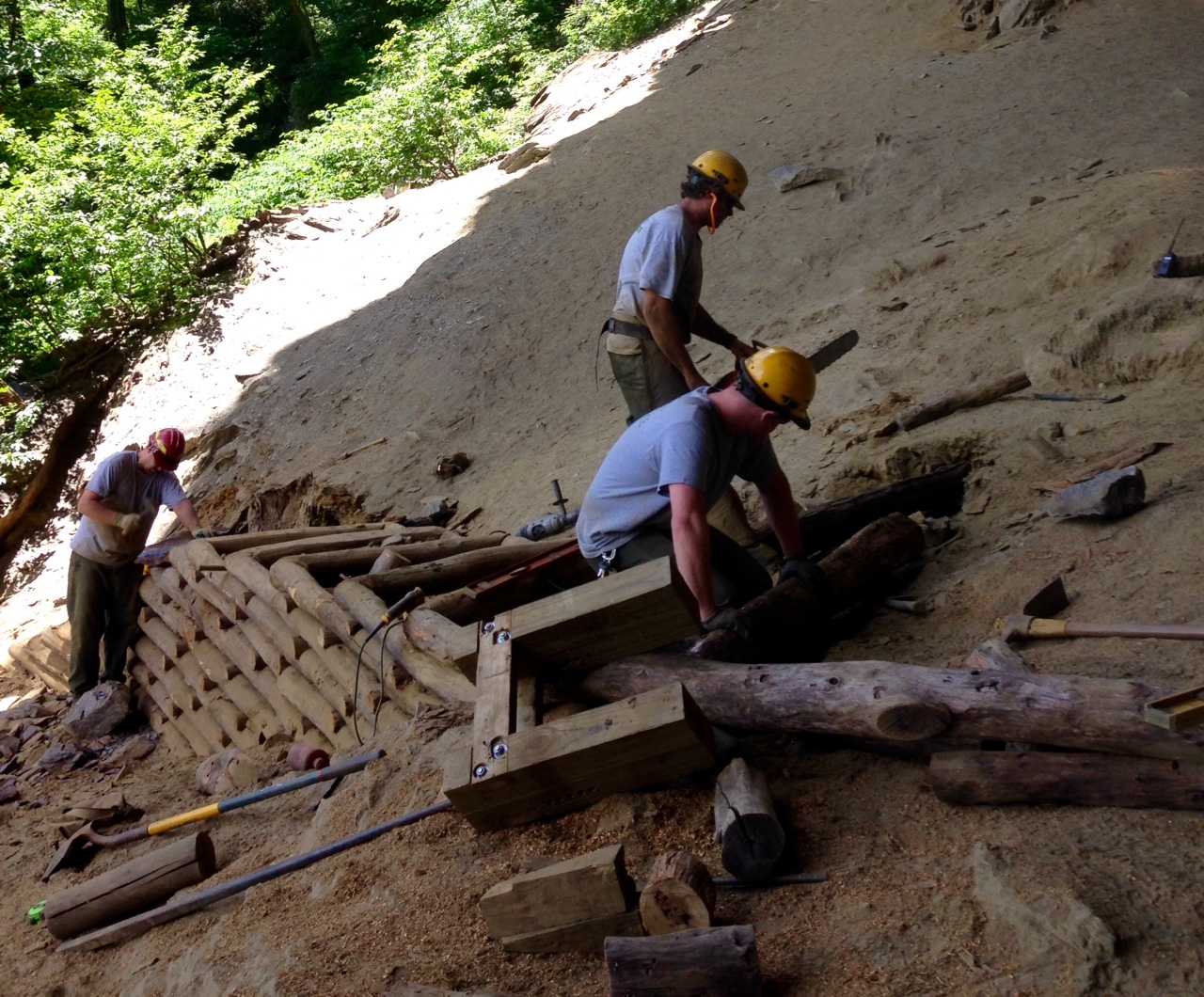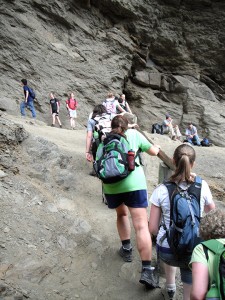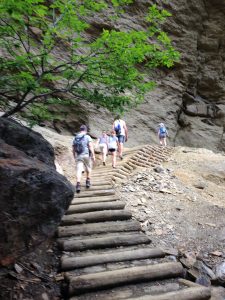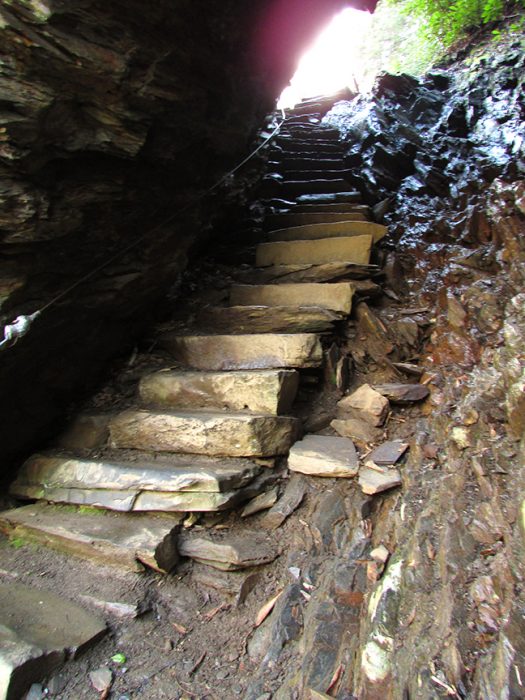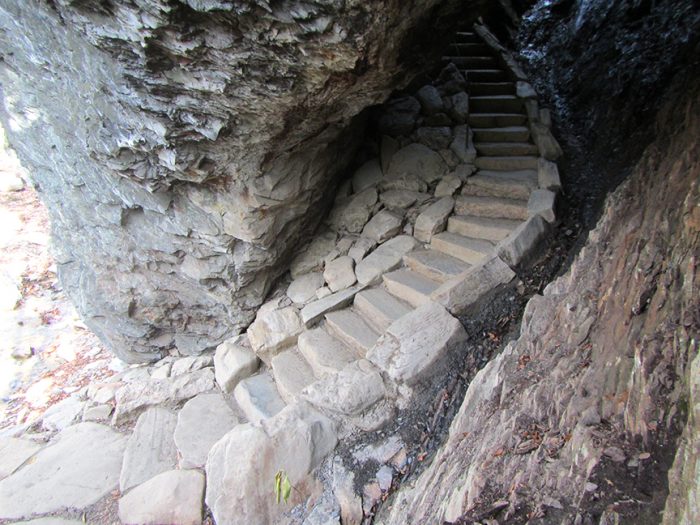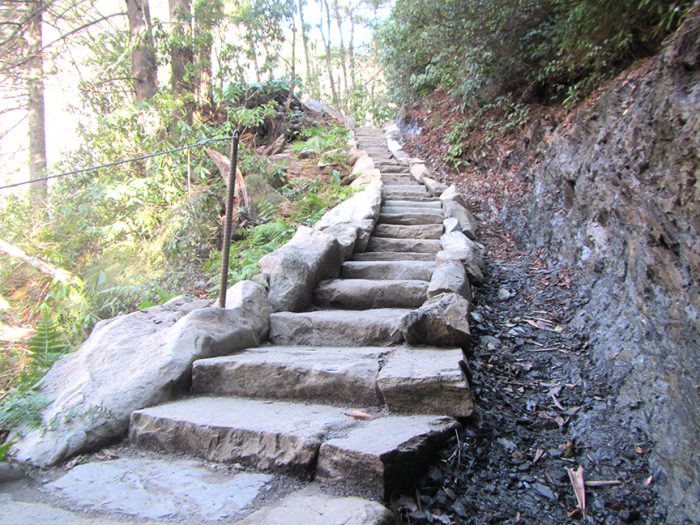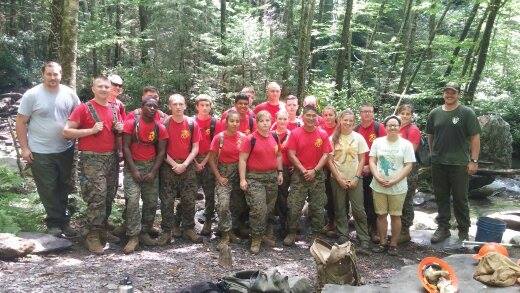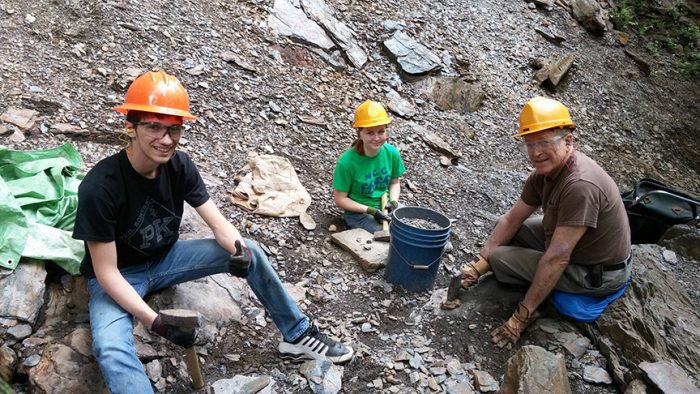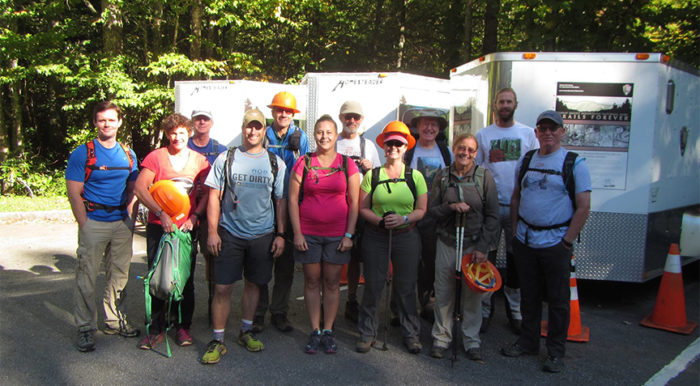by Julie Dodd
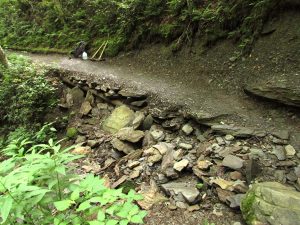
Restoration work on the Alum Cave Trail, one of the most popular trails in the Smokies, will be completed in November.
This is the second year the Trails Forever Crew, funded by Friends of the Smokies worked on the trail. The trail has been closed to hikers from Mondays through Thursdays from early May to mid-November.
If you’ve had the opportunity to hike the trail recently, you’ve seen the many improvements to the trail. Some of the most notable are the improved stairs in Arch Rock and the addition of a log staircase at Alum Cave Bluffs.
Because the trail is so scenic, the trail is heavily used. The restoration work makes the trail safer — tree roots and rocks were removed, some sections of the trail were widened, and the cable handrails were repaired.

Trail improvements also will help rescue crews that have to assist hikers injured on the trail. Navigating sections, such as Arch Rock, with an injured hiker on a litter (stretcher) will be easier. The trail work also improved sections of the trail that were eroding or had been damaged by landslides.
I asked Josh Shapiro, the Trails Forever Crew Supervisor for the Alum Cave Trail restoration, about the project.
FOTS: Alum Cave Trail was selected for renovation by the Trails Forever crew due to the trail’s popularity. You’ve worked to make trail improvements for both the hikers and the emergency crews that must make rescues of injured hikers. Can you give a couple of examples of those trail improvements.
Josh Shapiro: We created a safer and more sustainable trail surface by removing rocks and roots from the trail, building new drainage structures, building staircases on steep grades, and chiseling away bedrock for a more even trail surface. Improvements also entailed fixing several footlog abutments and building a new bridge.
Log staircase at Alum Cave Bluff
FOTS: One of the major renovations was the building of the log staircase at Alum Cave Bluff. What was involved in creating that staircase?
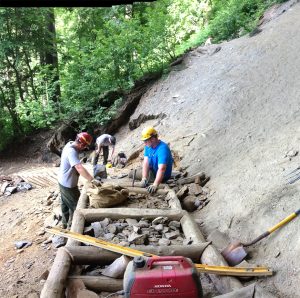
Josh Shapiro: There wasn’t a defined trail that went up through the bluff area. There were about three different routes hikers would take. We wanted to limit hiker impact to one defined trail.
After exhausting several different ideas, we came up with one route that would be the most sustainable and hiker friendly.
From that point, we looked for stone (at the worksite) to build the staircase but quickly realized that there wasn’t enough and that the quality of the stone was poor for building.
Our first choice for trail structures is always stone. When we can’t use stone, we use Black Locust. We measured out the length of the staircase and calculated the number of steps.
We obtained the locust in 8-foot-log sections and arranged for it to be flown to the site and dropped off by helicopter. The locust was flown up in November of last year. The crew began building the staircase in May of this year.
New bridge near Arch Rock
FOTS: A new bridge was installed in a section of the trail about a third of a mile before Arch Rock (as you hike from the parking lot). What were the logistics that were involved?
Josh Shapiro: We built a two-stringer locust bridge to replace a narrow and failing foot log. That particular foot log was a concern to the Park Rangers because it was very difficult to get a rescue litter across.
The trail crew decided to make a 60”-wide two-stringer foot bridge out of Black Locust. Black Locust is very rot resistant and can outlast any other timber species found in the Smokies.
The trail crew located two 40-foot-long locust trees and had them transported to the maintenance facility. At the facility, the crew built the bridge, which consisted of two 40-foot-long locust stringers, locust decking, and a locust hand rail on both sides of the bridge.
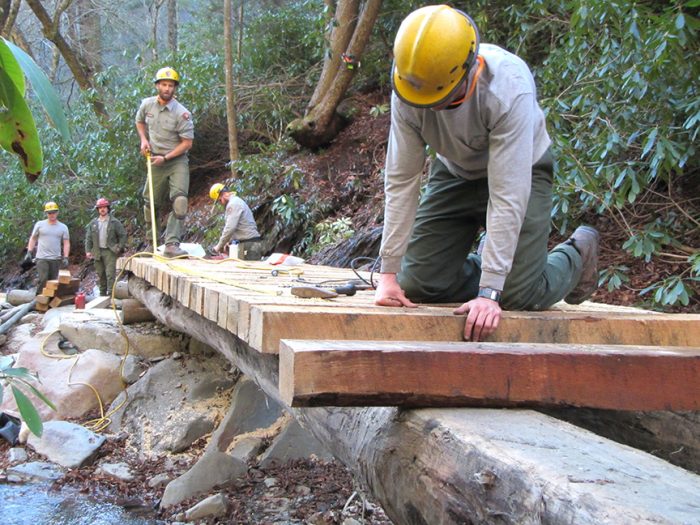
The bridge was constructed at the maintenance facility because of the proximity to specialized tools and equipment. The constructed bridge was then taken apart and transported one mile up Alum Cave Trail. Each individual piece was clearly marked to make reinstallation go smoothly. The decking, hardware, and handrails were packed up Alum Cave Trail by our mule team.
The 40-foot-long stringers proposed a much bigger challenge. They were dragged up the trail by the mules and a gasoline powered capstan winch. Transporting the materials from the trailhead to the bridge site took about one week.
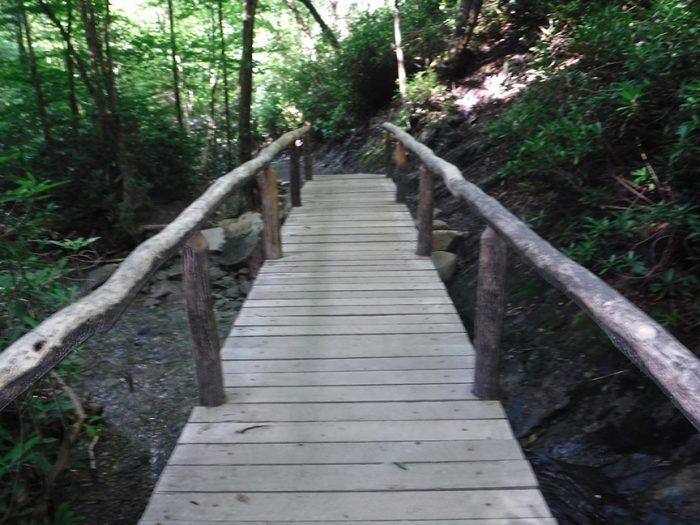
Once all of the materials arrived, the trail crew removed the narrow footlog and rebuilt the new bridge in less than a week.
Planning required for trail restoration
FOTS: You were the planner for the Trails Forever project. What are some examples of the planning required?
Josh Shapiro: A lot of planning went into this project. Before we began this project, Tobias Miller (the Supervisory Facility Operations Specialist for the trail work) and the crew surveyed the trail. We looked at all of the deficiencies on the trail pertaining to erosion, hiker safety, resource damage, and the current conditions of the trail structures (foot logs, timber and stone staircases, culverts, bridges, retaining walls, etc.).
After surveying the trail, we came up with a plan to accomplish all of the work to a standard that would match that of the typical park visitor. Alum Cave Trail is most typically used by day hikers wanting to hike to Arch Rock, Alum Cave or Mt. Le Conte.
We determined that a crew of 32 was needed to accomplish the work over two seasons. The work force consisted of 10 NPS Trails Staff and 22 Conservation Corps Members from American Conservation Experience (ACE). We are very fortunate to have such a skilled and passionate trail crew.
FOTS: Another part of the Trails Forever work is including volunteers to help work on the trail. What are some of the different roles that the volunteers have taken on?
Josh Shapiro: During the two-year project volunteers have worked over 1,500 hours! Volunteers serve a very important role in the work at Alum Cave Trail. Projects for volunteers have included cutting back vegetation to open the trail corridor, rock/root removal from the trail surface, transplanting vegetation to cover up social trails, and digging trail drainages.
FOTS: When I was a volunteer with you on the Chimney Tops and Alum Cave Trails restoration, you made the point about the quality of work being at a level to last 50 years or more and be similar to the long-lasting CCC (Civilian Conservation Corps) work in the park. Can you explain how that standard affects how a trail project is designed and completed?
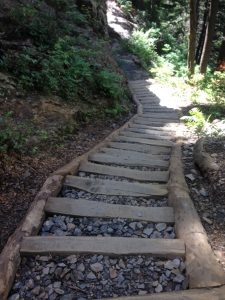
Josh Shapiro: The best compliment that we can receive is that our work is comparable with that of the CCC.
We take great care in ensuring that the rock work, timber work, bridges, and trail work in general is built to a very high standard.
We also take care to transplant vegetation and spread duff (mulch) at each project site to blend our structures in to the natural landscape.
Stone is always our building material of choice for staircases, retaining walls, stone culverts, etc.
When stone isn’t available we use Black Locust logs. Black Locust is very rot resistant and can last in the ground for decades.
In order to build to a 50-plus-year standard, the crew needs the proper amount of time to work on projects, the right equipment and building material, enough workers, and most importantly the right skill level.
We are very fortunate to have such a highly skilled trail crew and to have the support of Friends of the Smokies.
Funding Trails Forever Crew
The Alum Cave Trail is the third trail restored by the Trails Forever Crew. The first restoration was the Forney Ridge Trail (2009-2011), and the second was the Chimney Tops Trail (2012-2014).
 The Park Service funds two trail crews – one in North Carolina and one in Tennessee – that maintain trails, such as removing fallen trees and improving trail drainage. The Trails Forever Crew is funded by Friends of the Smokies to restore popular trails in the park.
The Park Service funds two trail crews – one in North Carolina and one in Tennessee – that maintain trails, such as removing fallen trees and improving trail drainage. The Trails Forever Crew is funded by Friends of the Smokies to restore popular trails in the park.
To volunteer with the Trails Forever Crew, find more information here.
To date, Friends of the Smokies has contributed more than $1 million for trail maintenance in GSMNP from proceeds of the $5 million Trails Forever endowment. You can make a contribution to support the Trails Forever program by clicking here.
